Nigerian Banks Employee Job Performance Evaluation
22 Pages6319 Words289 Views
Added on 2023-06-12
About This Document
This article discusses the impact of transformational and transactional leadership styles on employee job satisfaction and commitment in the Nigerian banking sector. It includes a literature review, theoretical framework, and empirical framework based on various researches conducted in the banking industry. The study concludes that transformational leadership styles are more effective in enhancing employee job satisfaction and commitment in the banking sector.
Nigerian Banks Employee Job Performance Evaluation
Added on 2023-06-12
ShareRelated Documents
Running Header: Nigerian Banks Employee Job Performance Evaluation 1
Nigerian Banks Employee Job Performance Evaluation
Students Name:
Students ID:
Date:
Nigerian Banks Employee Job Performance Evaluation
Students Name:
Students ID:
Date:
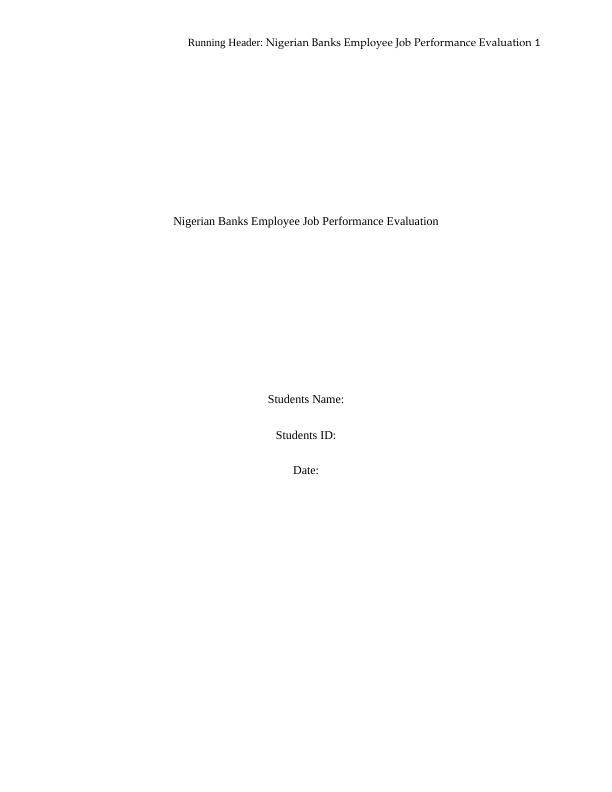
Nigerian Banks Employee Job Performance Evaluation 2
Literature Review
Introduction
Leadership has various definitions making it very difficult to come up with a definite definition
that works (Bolden & Gosling, 2006). Leadership has been referred to as a body or group of
people who are tasked with leading and directing the activities of a group in order to achieve a
shared goal (Wieseke et al., 2009). According to Ogbeidi (2012), he defines leadership as the
ability to direct, organize and lead a group. Conversely, according to Certo (2002), leadership
means that it is a process which directs the behavior of others to accomplish their goals and
objectives. Certo sees leadership as a vigorous practice in a group whereby an individual
influences or guides the other members of the group to pledge themselves entirely to achieve the
tasks or goals of the group. The process usually takes over a certain time period especially in a
particular setting such as an organization.
Transformational leadership is a process which influences the major modifications in
assumptions and attitudes of members in an organization and builds commitment to the
objectives and missions of the organization (Chelladurai, 2001). A transformational leader is an
extraordinary leader as he or she raises the levels of consciousness with regards to the value and
importance of selected outcomes and the various ways of accomplishing them (Bass & Riggio,
2006). Such leaders persuade their followers to surpass their own instantaneous self-interest for
the sake of the organization’s vision and mission.
On the other hand, transactional leadership consists of management by exception (can be either
passive or active) and contingent reward. According to Antonakis and House (2013), active
management by exception is where the leadership style performance is monitored actively for
Literature Review
Introduction
Leadership has various definitions making it very difficult to come up with a definite definition
that works (Bolden & Gosling, 2006). Leadership has been referred to as a body or group of
people who are tasked with leading and directing the activities of a group in order to achieve a
shared goal (Wieseke et al., 2009). According to Ogbeidi (2012), he defines leadership as the
ability to direct, organize and lead a group. Conversely, according to Certo (2002), leadership
means that it is a process which directs the behavior of others to accomplish their goals and
objectives. Certo sees leadership as a vigorous practice in a group whereby an individual
influences or guides the other members of the group to pledge themselves entirely to achieve the
tasks or goals of the group. The process usually takes over a certain time period especially in a
particular setting such as an organization.
Transformational leadership is a process which influences the major modifications in
assumptions and attitudes of members in an organization and builds commitment to the
objectives and missions of the organization (Chelladurai, 2001). A transformational leader is an
extraordinary leader as he or she raises the levels of consciousness with regards to the value and
importance of selected outcomes and the various ways of accomplishing them (Bass & Riggio,
2006). Such leaders persuade their followers to surpass their own instantaneous self-interest for
the sake of the organization’s vision and mission.
On the other hand, transactional leadership consists of management by exception (can be either
passive or active) and contingent reward. According to Antonakis and House (2013), active
management by exception is where the leadership style performance is monitored actively for
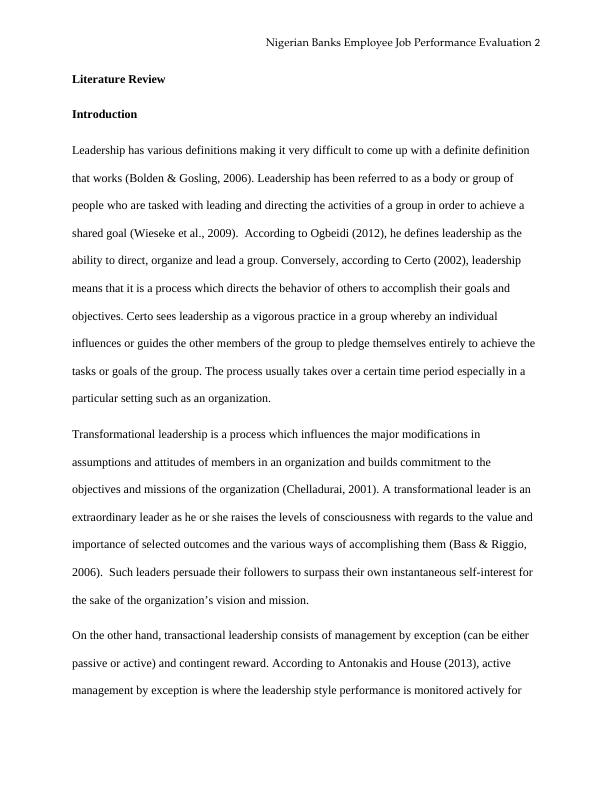
Nigerian Banks Employee Job Performance Evaluation 3
blunders while passive management by exception leaders wait to learn of such errors. Contingent
reward provides a reward for completion of contracts while management by exception avoids
giving out directions where the current methods work and goals of performance are met (Barling
et al. 2000).
Theoretical Framework
The theoretical framework aims at discussing the existing theories which are behind a certain
phenomenon or a fact. Various theories have been formulated in line with leadership styles.
Some of the most common leadership styles identified include transactional leadership styles and
transformational leadership style, and laissez-fair (Spinelli, 2006). Transformational and
transactional theories provide an expedient lens for comprehending how leaders impact the
management of the knowledge of the organization (Epstein & Zin, 2013).
Transformational Leadership
According to Robbins and Coulter (2007), transformational leaders stimulate and inspire
followers to produce extraordinary output. A transformational leader pays attention to the
developmental needs and concerns of every follower as they change the awareness of the
follower’s issues as they assist them to look at problems differently. In turn, they are capable of
arousing, exciting and inspiring their subordinates to put extra effort so as to achieve the goals of
the group (Sims & Brinkman, 2002). The theory behind transformational leadership revolves
around leadership as a means that creates positive changes in the followers or subordinates since
the interest of every individual is taken care of as they aim to act in the whole group’s interest
(Warrilow, 2012).
blunders while passive management by exception leaders wait to learn of such errors. Contingent
reward provides a reward for completion of contracts while management by exception avoids
giving out directions where the current methods work and goals of performance are met (Barling
et al. 2000).
Theoretical Framework
The theoretical framework aims at discussing the existing theories which are behind a certain
phenomenon or a fact. Various theories have been formulated in line with leadership styles.
Some of the most common leadership styles identified include transactional leadership styles and
transformational leadership style, and laissez-fair (Spinelli, 2006). Transformational and
transactional theories provide an expedient lens for comprehending how leaders impact the
management of the knowledge of the organization (Epstein & Zin, 2013).
Transformational Leadership
According to Robbins and Coulter (2007), transformational leaders stimulate and inspire
followers to produce extraordinary output. A transformational leader pays attention to the
developmental needs and concerns of every follower as they change the awareness of the
follower’s issues as they assist them to look at problems differently. In turn, they are capable of
arousing, exciting and inspiring their subordinates to put extra effort so as to achieve the goals of
the group (Sims & Brinkman, 2002). The theory behind transformational leadership revolves
around leadership as a means that creates positive changes in the followers or subordinates since
the interest of every individual is taken care of as they aim to act in the whole group’s interest
(Warrilow, 2012).
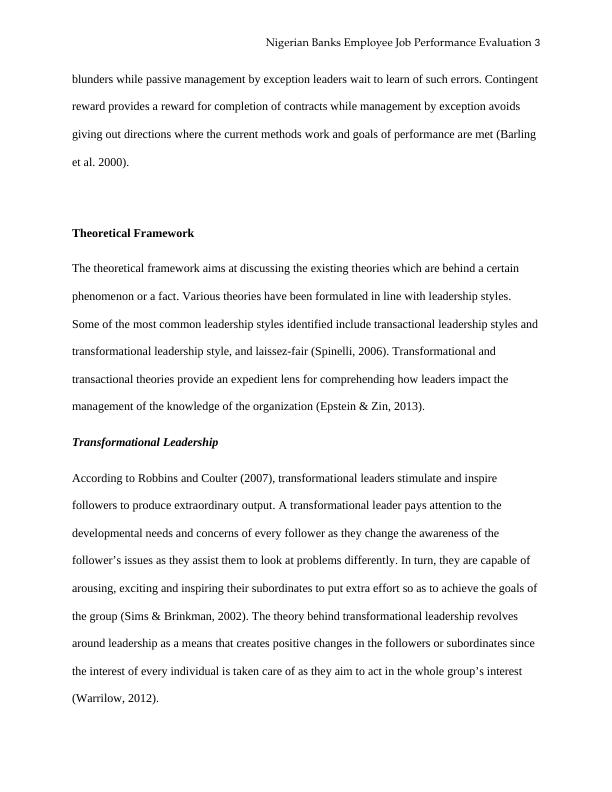
Nigerian Banks Employee Job Performance Evaluation 4
Zhu et al. (2012) states that the transformational leadership concept was introduced in 1978 by
James McGregor Burns. James made this milestone in his research, which was descriptive in
nature, on political leaders. Consequently, the adoption of the theory has spread into psychology
and organizational management with further alterations done on it by J.B Avalio and B.M Bass.
Transformational leadership boosts morale, performance, and motivation of subordinates through
an assortment of mechanisms. The mechanisms include establishing a sense of identity of the
followers or subordinates and self to the project and the organization's collective identity.
Moreover, the mechanism entails the leader being a role model to their subordinates to inspire
them and make them interested. Through this, the subordinates get challenged to take great
ownership of their work as the leaders make efforts in comprehending their strength and
weakness (Gardner et al., 2005). As a result, the leaders will have an upper hand in aligning the
subordinates with tasks which will improve their performance.
Warrilow (2012) recognized transformational leadership styles as charisma or idealized
influence, intellectual stimulation and personal, inspirational motivation, and individual
attention. A charismatic leader or a leader who idealizes influence behave in an admirable way
and exhibits conviction while taking a stand that causes his subordinates/followers to identify
with a leader who has a clear set of values. Thus, the leaders act as a role model to his or her
followers or subordinates. A leader who inspires motivation articulates clearly the visions which
appeal and inspires the subordinates with optimism regarding future goals as they offer a
meaning for the current task at hand (Oreg & Berson, 2011). A leader who stimulates
intellectuals challenges assumptions and encourages the followers to be creative. They provide a
framework for the followers in a bid to see how they associate with the organization and the
leader. Thus, the two have the potential to overcome any obstacle creatively in the mission’s
Zhu et al. (2012) states that the transformational leadership concept was introduced in 1978 by
James McGregor Burns. James made this milestone in his research, which was descriptive in
nature, on political leaders. Consequently, the adoption of the theory has spread into psychology
and organizational management with further alterations done on it by J.B Avalio and B.M Bass.
Transformational leadership boosts morale, performance, and motivation of subordinates through
an assortment of mechanisms. The mechanisms include establishing a sense of identity of the
followers or subordinates and self to the project and the organization's collective identity.
Moreover, the mechanism entails the leader being a role model to their subordinates to inspire
them and make them interested. Through this, the subordinates get challenged to take great
ownership of their work as the leaders make efforts in comprehending their strength and
weakness (Gardner et al., 2005). As a result, the leaders will have an upper hand in aligning the
subordinates with tasks which will improve their performance.
Warrilow (2012) recognized transformational leadership styles as charisma or idealized
influence, intellectual stimulation and personal, inspirational motivation, and individual
attention. A charismatic leader or a leader who idealizes influence behave in an admirable way
and exhibits conviction while taking a stand that causes his subordinates/followers to identify
with a leader who has a clear set of values. Thus, the leaders act as a role model to his or her
followers or subordinates. A leader who inspires motivation articulates clearly the visions which
appeal and inspires the subordinates with optimism regarding future goals as they offer a
meaning for the current task at hand (Oreg & Berson, 2011). A leader who stimulates
intellectuals challenges assumptions and encourages the followers to be creative. They provide a
framework for the followers in a bid to see how they associate with the organization and the
leader. Thus, the two have the potential to overcome any obstacle creatively in the mission’s
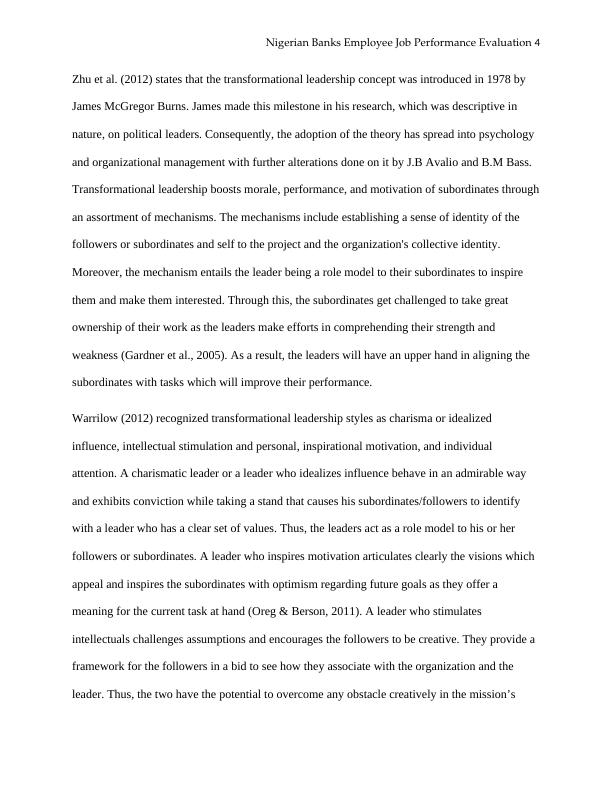
Nigerian Banks Employee Job Performance Evaluation 5
way. A leader should turn his or her attention to a follower or subordinate on an individual basis.
Through this, a leader has to attend to the individual needs as they act as mentors or coaches as
they give respect and appreciation of the contribution of the individual to the team. Personal
attention satisfies and enriches every individual in the team through self-worth and self-
fulfillment. Thus, they get inspired to go the extra mile in achieving their targets and growing.
Transactional Leadership
Transactional leadership is also known as managerial leadership. Transactional leadership
focuses on the role of group performance, organization, and supervision (Judge & Piccolo,
2004). Through transactional leadership, the leader upholds submission of his or her subordinates
via punishments and rewards. Transactional leadership differs from transformational leadership
as leaders who value the transactional approach do not look forward to changing the future.
Thus, they want to keep things looking the same way they are. Transactional leadership is very
effective when there is a situation in the firm which creates a crisis or an emergency (Wayne et
al., 2002). More so, it is very appropriate when there is a project that needs to be carried out in an
explicit way. Transactional leadership works at the basic levels of satisfaction needs within the
context of Maslow’s hierarchy of needs. Thus, transactional leaders put emphasis on the
hierarchy’s lower levels. According to Day et al. (2001), transactional leaders use a model of
exchange which rewards for positive outcomes or good work. On the other hand, leadership style
spear headers punish negative outcomes or poor work till the problem is corrected. Such leaders
are very effective and efficient in getting precise tasks accomplished through the management of
each portion individually. A fact that can be attributed to the essence that such leaders are
concerned with the process and do not have a forward thinking of ideas.
way. A leader should turn his or her attention to a follower or subordinate on an individual basis.
Through this, a leader has to attend to the individual needs as they act as mentors or coaches as
they give respect and appreciation of the contribution of the individual to the team. Personal
attention satisfies and enriches every individual in the team through self-worth and self-
fulfillment. Thus, they get inspired to go the extra mile in achieving their targets and growing.
Transactional Leadership
Transactional leadership is also known as managerial leadership. Transactional leadership
focuses on the role of group performance, organization, and supervision (Judge & Piccolo,
2004). Through transactional leadership, the leader upholds submission of his or her subordinates
via punishments and rewards. Transactional leadership differs from transformational leadership
as leaders who value the transactional approach do not look forward to changing the future.
Thus, they want to keep things looking the same way they are. Transactional leadership is very
effective when there is a situation in the firm which creates a crisis or an emergency (Wayne et
al., 2002). More so, it is very appropriate when there is a project that needs to be carried out in an
explicit way. Transactional leadership works at the basic levels of satisfaction needs within the
context of Maslow’s hierarchy of needs. Thus, transactional leaders put emphasis on the
hierarchy’s lower levels. According to Day et al. (2001), transactional leaders use a model of
exchange which rewards for positive outcomes or good work. On the other hand, leadership style
spear headers punish negative outcomes or poor work till the problem is corrected. Such leaders
are very effective and efficient in getting precise tasks accomplished through the management of
each portion individually. A fact that can be attributed to the essence that such leaders are
concerned with the process and do not have a forward thinking of ideas.
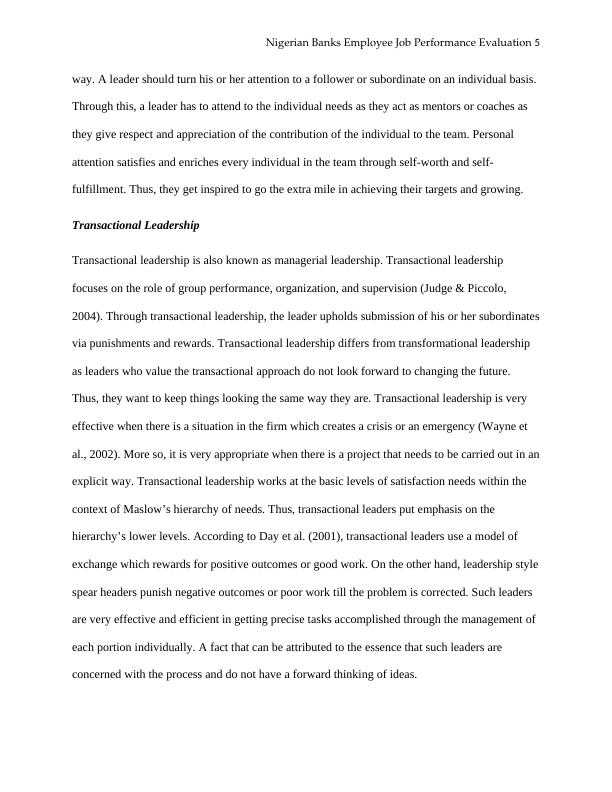
Nigerian Banks Employee Job Performance Evaluation 6
Transactional leaders tend to put more focus on contingent reward (contingent positive
reinforcement) or contingent penalization (contingent negative reinforcement). Contingent
rewards such as commendations are given when a subordinate accomplish the set goals ahead of
time or on-time. Moreover, they are used to maintain the subordinate at a desired positive pace at
various times all the way to completion (Brown & Moshavi, 2002). Contingent punishment such
as suspension is usually handed out when the quantity or quality of a performance falls below the
standards desired or when the tasks are not met at all. In most cases, contingent punishments are
handed down on a management on an exception basis in which the exception is something that is
wrong. An active management through exception shows that the leader looks at the performance
of each subordinate continuously and makes changes to the work of the subordinate to make
corrections throughout the process. On the other hand, passive management through exception
leaders chooses to wait for issues to rise before attempting to fix the problems. Transactional
leadership underpins transformational leadership as it is applied to the needs of the lower level
and its style is more managerial.
Transactional leaders have two tools, rewards and punishment, so as to gain compliance from
their subordinates (Walumbwa et al., 2008). They are motivators who are extrinsic as they bring
minimal compliance from their subordinates. They consent to the structure, culture and the goals
of the existing companies. Thus, they tend to be more action-oriented and directive. Thus, they
are more willing to work within the systems that are in existence as they negotiate to accomplish
the organization’s goals. Transactional leaders have a tendency to think inside the box when it
comes to problem-solving since the leadership style is primarily passive. Behaviors that are
linked mostly with this leadership style are the establishment of the benchmarks for gratifying
followers and the maintenance of the status quo. Transactional leadership entails two factors that
Transactional leaders tend to put more focus on contingent reward (contingent positive
reinforcement) or contingent penalization (contingent negative reinforcement). Contingent
rewards such as commendations are given when a subordinate accomplish the set goals ahead of
time or on-time. Moreover, they are used to maintain the subordinate at a desired positive pace at
various times all the way to completion (Brown & Moshavi, 2002). Contingent punishment such
as suspension is usually handed out when the quantity or quality of a performance falls below the
standards desired or when the tasks are not met at all. In most cases, contingent punishments are
handed down on a management on an exception basis in which the exception is something that is
wrong. An active management through exception shows that the leader looks at the performance
of each subordinate continuously and makes changes to the work of the subordinate to make
corrections throughout the process. On the other hand, passive management through exception
leaders chooses to wait for issues to rise before attempting to fix the problems. Transactional
leadership underpins transformational leadership as it is applied to the needs of the lower level
and its style is more managerial.
Transactional leaders have two tools, rewards and punishment, so as to gain compliance from
their subordinates (Walumbwa et al., 2008). They are motivators who are extrinsic as they bring
minimal compliance from their subordinates. They consent to the structure, culture and the goals
of the existing companies. Thus, they tend to be more action-oriented and directive. Thus, they
are more willing to work within the systems that are in existence as they negotiate to accomplish
the organization’s goals. Transactional leaders have a tendency to think inside the box when it
comes to problem-solving since the leadership style is primarily passive. Behaviors that are
linked mostly with this leadership style are the establishment of the benchmarks for gratifying
followers and the maintenance of the status quo. Transactional leadership entails two factors that
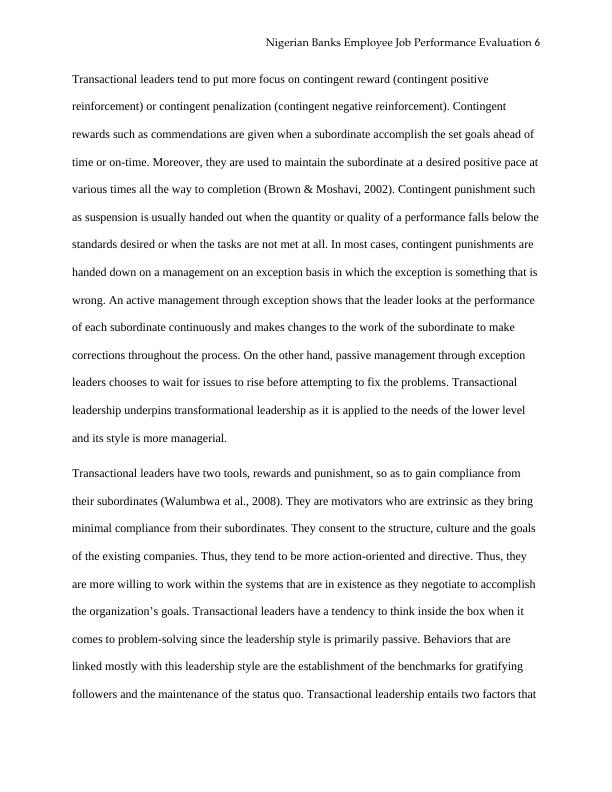
End of preview
Want to access all the pages? Upload your documents or become a member.
Related Documents
Effect of Transactional and Transformational Leadership Styles on Staff Performancelg...
|24
|3827
|27
Leadership in a Changing context PDFlg...
|24
|3641
|25
Leadership and Management in Organization and Business Strategylg...
|12
|3449
|24
The Transformational Leadership Style of J & J Furnishings, Ltdlg...
|8
|2197
|102
Responsible For Stimulating And Inspiringlg...
|14
|2570
|12
Organisation Design and Management - Deskliblg...
|11
|2658
|318
